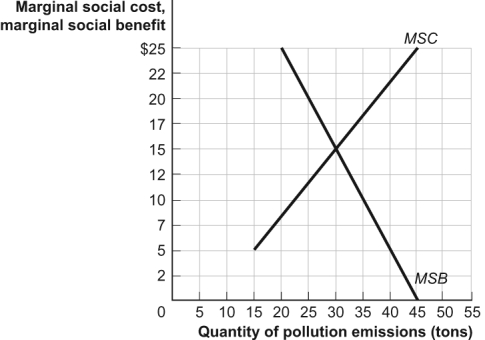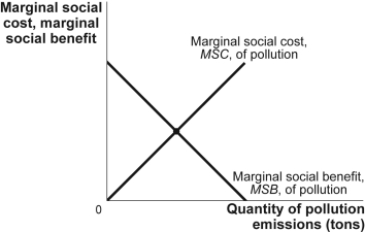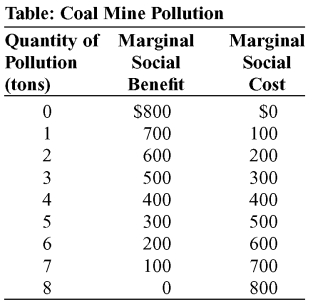A) $5; 40
B) $15; 30
C) $25; 30
D) $15; 15
Correct Answer

verified
Correct Answer
verified
Multiple Choice
Which of the following is a positive externality?
A) Sam dug a pond so he could go fishing, but the pond has contributed to an explosion of mosquitoes in your neighborhood.
B) Sam has dozens of cats, and they come into your yard to hunt the birds that come to your birdbath.
C) Sam buys a dilapidated house, renovates it, and increases the property values of all houses in the neighborhood.
D) Liquid waste from Sam's chicken farm flows into a neighbor's well water.
Correct Answer

verified
Correct Answer
verified
Multiple Choice
Suppose the production of roses generates a positive externality in that travelers enjoy the scenic beauty of the garden. An appropriate government policy yielding the efficient outcome would be a:
A) Pigouvian tax.
B) Pigouvian subsidy.
C) system of rose production permits.
D) reduction in transaction costs.
Correct Answer

verified
Correct Answer
verified
True/False
According to the Coase theorem, only when transaction costs are extremely high can two parties internalize a negative externality.
Correct Answer

verified
Correct Answer
verified
Multiple Choice
If the marginal social benefit received from pollution is equal to its marginal social cost:
A) society's well-being can be improved if the quantity of pollution increases.
B) society's well-being can be improved if the quantity of pollution decreases.
C) society has achieved its socially optimal level of pollution.
D) the market is producing too much pollution.
Correct Answer

verified
Correct Answer
verified
True/False
A principal cause of market failure is actions generating side effects that are not properly taken into account by the market.
Correct Answer

verified
Correct Answer
verified
Multiple Choice
Both emissions taxes and tradable emissions permits:
A) are efficient cost-minimizing methods of pollution reduction.
B) work only if they are coupled with environmental standards.
C) encourage more pollution.
D) are usually less effective than environmental standards.
Correct Answer

verified
Correct Answer
verified
Multiple Choice
A market economy will produce _____ without any government regulation.
A) too little pollution
B) too much pollution
C) the socially optimal amount of pollution
D) the amount of pollution that maximizes total surplus
Correct Answer

verified
Correct Answer
verified
Multiple Choice
Which of the following is NOT an activity that generates an externality?
A) Bob's Service Station dumps used oil in the river.
B) Bob renovates a run-down house in the neighborhood.
C) Bob occasionally drives while drunk.
D) Bob's Service Station donates a car to charity.
Correct Answer

verified
Correct Answer
verified
Multiple Choice
Which of the following is a negative externality?
A) high prices for necessities such as drinking water in the aftermath of a natural disaster
B) the risks to nonsmokers from second-hand smoke
C) the increased risk of a traffic accident to an individual who uses a cell phone while driving
D) unemployment in the steel industry caused by low prices of imported (external) steel
Correct Answer

verified
Correct Answer
verified
Multiple Choice
For the same amount of pollution emitted, an emissions tax is said to be more efficient than an environmental standard because all polluters:
A) emit pollution up to the point at which the marginal benefit of polluting is equal to the emissions tax.
B) emit the same amount of pollution, regardless of the marginal benefit of polluting.
C) pay the same total tax bill for their pollution.
D) reduce pollution emissions to zero.
Correct Answer

verified
Correct Answer
verified
Multiple Choice
Suppose the federal government determines the total level of municipal sewage that can be discharged by cities along a river. If the cities are able to buy and sell rights to the total discharge level among themselves, then the government's environmental policy includes:
A) emissions taxes.
B) regulations.
C) tradable pollution permits.
D) command and control.
Correct Answer

verified
Correct Answer
verified
Multiple Choice
Use the following to answer questions:  -(Table: Externalities from Parks) The table Externalities from Parks shows the marginal social benefit and the marginal social cost of preserving various amounts of land in a city for a public park. The socially optimum amount of land dedicated to the public park will be _____ acres.
-(Table: Externalities from Parks) The table Externalities from Parks shows the marginal social benefit and the marginal social cost of preserving various amounts of land in a city for a public park. The socially optimum amount of land dedicated to the public park will be _____ acres.
A) 0
B) 1
C) 3
D) 9
Correct Answer

verified
Correct Answer
verified
Multiple Choice
Use the following to answer questions:
Figure: Efficiency and Pollution  -(Figure: Efficiency and Pollution) Look at the figure Efficiency and Pollution. If the government imposed an environmental standard that did NOT allow the quantity of pollution to exceed 30 tons, there would be:
-(Figure: Efficiency and Pollution) Look at the figure Efficiency and Pollution. If the government imposed an environmental standard that did NOT allow the quantity of pollution to exceed 30 tons, there would be:
A) a socially optimal quantity of pollution.
B) too little pollution, because its marginal social benefit would exceed its marginal social cost.
C) too much pollution, because its marginal social cost would exceed its marginal social benefit.
D) too much pollution, because any pollution is too much from an economist's perspective.
Correct Answer

verified
Correct Answer
verified
True/False
According to the Coase theorem, the inefficiencies caused by externalities can be removed by the private sector if individuals enter into appropriately structured deals, provided that the transaction costs of such deals are sufficiently low.
Correct Answer

verified
Correct Answer
verified
Multiple Choice
Use the following to answer questions:
Figure: The Socially Optimal Quantity of Pollution  -(Figure: The Socially Optimal Quantity of Pollution) In the figure The Socially Optimal Quantity of Pollution, the optimal quantity of pollution:
-(Figure: The Socially Optimal Quantity of Pollution) In the figure The Socially Optimal Quantity of Pollution, the optimal quantity of pollution:
A) could be achieved with a Pigouvian subsidy.
B) is unlikely to be achieved without government intervention.
C) could be achieved with a Pigouvian tax.
D) is unlikely to be achieved without government intervention, but it could be achieved with a Pigouvian tax.
Correct Answer

verified
Correct Answer
verified
Multiple Choice
Use the following to answer questions:  -(Table: Externalities from Parks) The table Externalities from Parks shows the marginal social benefit and the marginal social cost of preserving various amounts of land in a city for a public park. At the socially optimum amount of land dedicated to the public park the marginal social cost will be:
-(Table: Externalities from Parks) The table Externalities from Parks shows the marginal social benefit and the marginal social cost of preserving various amounts of land in a city for a public park. At the socially optimum amount of land dedicated to the public park the marginal social cost will be:
A) $225.
B) $150.
C) $100.
D) $0.
Correct Answer

verified
Correct Answer
verified
Multiple Choice
Pollution has _____ and _____.
A) no benefits; only costs
B) benefits; costs
C) no opposition; only advocates
D) short-term effects; very little long-term effect
Correct Answer

verified
Correct Answer
verified
Multiple Choice
Assume the price of a tradable emissions permit for a ton of sulfur dioxide is $150. Which of the following is INCORRECT?
A) A firm that buys permits has an incentive to limit pollution to the point at which the marginal benefit of emissions is equal to $150.
B) A firm that has more permits than it plans to use has an incentive to limit pollution to the point at which the marginal benefit of emissions is equal to $150.
C) The opportunity cost of emitting a ton of sulfur dioxide is $75 for all firms.
D) The opportunity cost of emitting a ton of sulfur dioxide is $150 for all firms.
Correct Answer

verified
Correct Answer
verified
Multiple Choice
Use the following to answer questions:  -(Table: Coal Mine Pollution) The table Coal Mine Pollution shows the marginal social benefit and cost of various amounts of pollution from a coal mine. If 5 tons of pollution is produced, the outcome is _____ because _____.
-(Table: Coal Mine Pollution) The table Coal Mine Pollution shows the marginal social benefit and cost of various amounts of pollution from a coal mine. If 5 tons of pollution is produced, the outcome is _____ because _____.
A) efficient; MSB = MSC
B) efficient; MSB > MSC
C) inefficient; MSB > MSC
D) inefficient; MSB < MSC
Correct Answer

verified
Correct Answer
verified
Showing 21 - 40 of 199
Related Exams